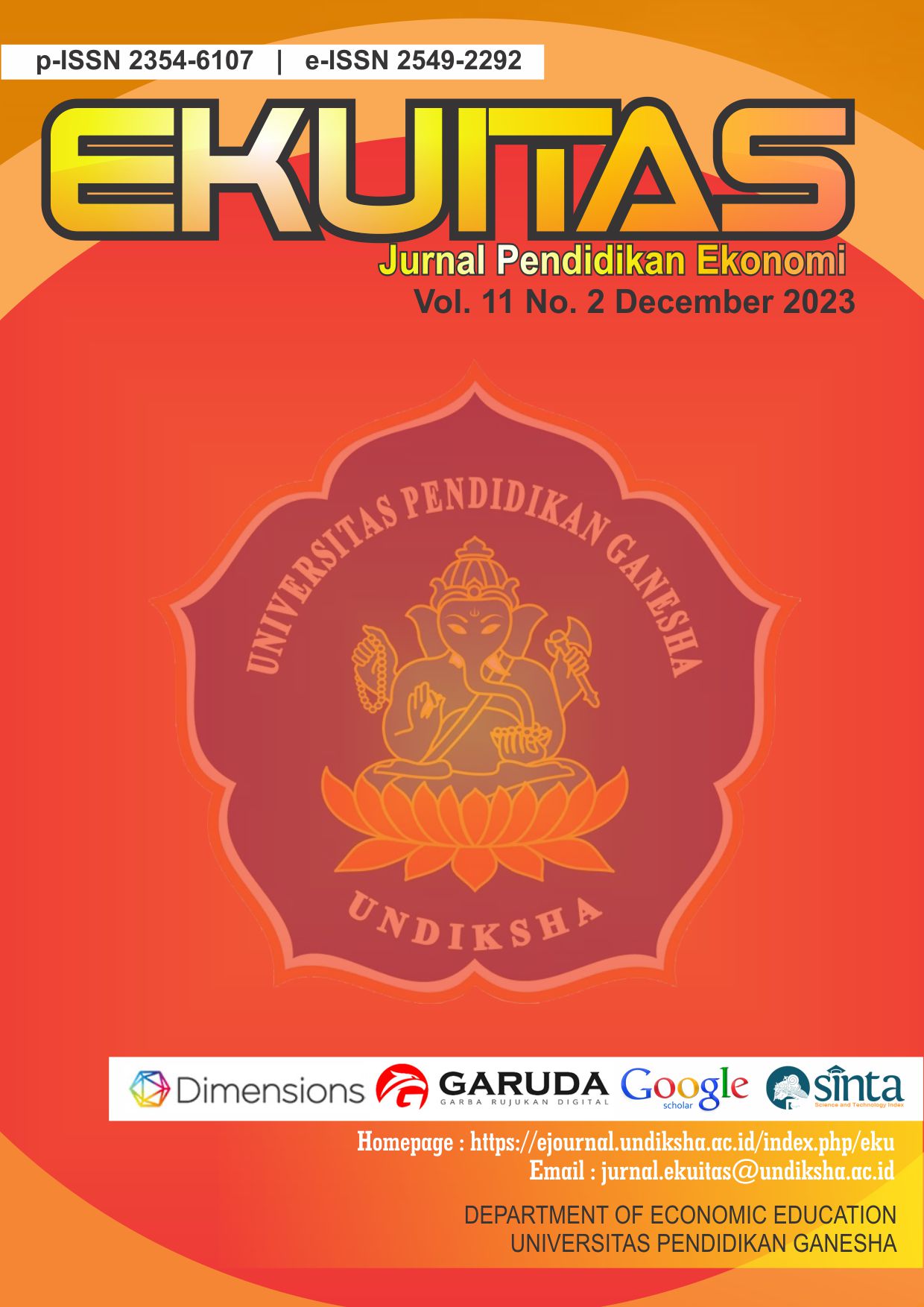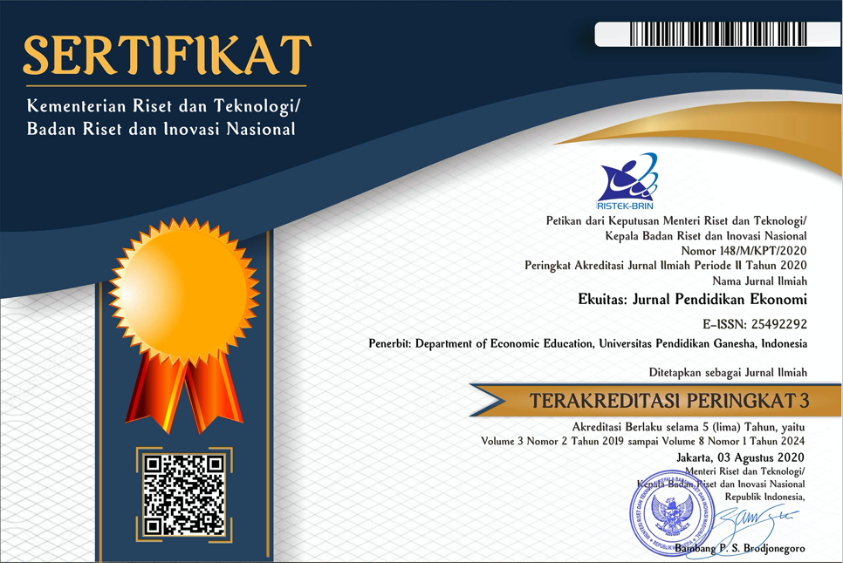Analisis Sektor Ekonomi Provinsi Gorontalo Tahun 2017-2022
DOI:
https://doi.org/10.23887/ekuitas.v11i2.68029Keywords:
Inequality, IW, leading sector, LQAbstract
Indonesia, as an archipelago, has different regional characteristics, so the problem of regional inequality cannot be avoided. The central government authorizes local governments to develop the potential of the region so that each region is required to be able to independently improve its economy. Gorontalo province, as a province of expansion in 2000, is in a strategic location that has great potential in the agricultural sector, as well as in mariculture an agriculture. The research objective is to determine the condition of economic inequality in Gorontalo province and the leading sectors in each district/city of Gorontalo province. Using time series data from 2017-2022, inequality is analyzed using the Williamson Index (IW), and to determine leading sectors, location quotient (LQ) analysis is used. The results show that the level of inequality in Gorontalo province is close to zero, which means that the condition of the level of income and welfare of the population is evenly distributed because the majority of population employment is still dominated by the agriculture, sector, which is the leading sector in Gorontalo, Boalemo, and North Gorontalo districts, and the trade sector, which is the leading sector in Boalemo and Bonebolango districts
References
Aprilianti, V., & Harkeni, A. (2021). PENGARUH INDEKS PEMBANGUNAN MANUSIA TERHADAP KETIMPANGAN WILAYAH DI PROVINSI JAMBI. Khazanah Intelektual, 5(2), 1142–1160. https://doi.org/https://doi.org/10.37250/newkiki.v4i1.111
BPS. (n.d.). BPS Provinsi Gorontalo. Gorontalo: Badan Pusat Statistik Provinsi Gorontalo. https://gorontalo.bps.go.id/
Br Surbakti, L. S., Marseto, M., & Sishadiyati, S. (2021). Analisis Pengembangan Sektor Ekonomi Unggulan Dalam Pertumbuhan Ekonomi Di Kota Medan. Jambura Economic Education Journal, 3(2), 143–151. https://doi.org/10.37479/jeej.v3i2.11055
Ibrahim, I. (2018). Analisis Potensi Sektor Ekonomi Dalam Upaya Peningkatan Pertumbuhan Ekonomi (Studi Empiris Pada Kabupaten dan Kota di Provinsi Gorontalo tahun 2012-2016). Gorontalo Development Review, 1(1), 44–58. https://doi.org/10.32662/golder.v1i1.113
Irkham, M. (2019). Analisis Ketimpangan Wilayah. Akuntabel, 16(1), 98–110. https://doi.org/https://doi.org/10.30872/jakt.v16i1.5385
Islami, F. S., & SBM, N. (2018). Faktor-faktor Mempengaruhi Ketimpangan Wilayah di Provinsi Jawa Timur, Indonesia. Media Ekonomi Dan Manajemen, 33(1), 59–67. https://doi.org/http://dx.doi.org/10.24856/mem.v33i1.564
Kuncoro, M. (2004). Otonomi dan Pembangunan Daerah: Reformasi, Perencanaan, Strategi dan Peluang. Jakarta: Erlangga.
Luthfiyah, U., & Tallo, A. J. (2020). Analisis Ketimpangan Ekonomi Provinsi Bali Tahun 2019. Aksara: Jurnal Ilmu Pendidikan Nonformal, 6(3), 241. https://doi.org/10.37905/aksara.6.3.241-248.2020
Maulana, A. (2019). Analisis Ketimpangan Pembangunan Antarkabupaten / Kota Di Provinsi Kalimantan. Jurnal Ilmu Ekonomi Dan Pembangunan, 19(1). https://doi.org/https://doi.org/10.20961/jiep.v19i1.25510
Nurfani, H. D., Dewanti, A. N., & Sitaresmi, D. T. (2020). Penentuan Kecamatan Basis Komoditas Padi Menggunakan Analisis LQ dan DLQ di Kabupaten Kutai Kartanegara. Jurnal Penelitian Pertanian Terapan, 20(3), 183–190. https://doi.org/http://dx.doi.org/10.25181/jppt.v20i3.1660
Palembang, M. F., Prahara, I., Nugraha, M. R. S., Astabella, R. D., Pramesti, R. A., Hayat, D. M., & Putri, R. F. (2021). Analysis of Economic Inequality and Human Development: A Case Study of West Sumatra Province in 2015-2019. E3S Web of Conferences, 325, 1–8. https://doi.org/10.1051/e3sconf/202132506001
Panggarti, U., Zumaeroh, Purnomo, S. D., Retnowati, D., & Adhitya, B. (2022). Studi Komparatif Ketimpangan Antar Pulau di Indonesia. Jurnal Ekonomi, Manajemen Dan Akuntansi, 24(2), 288–298. https://doi.org/10.29264/jfor.v24i2.10988
Rizani, A. (2019). Analisis Sektor Potensi Unggulan Guna Perencanaan Pembangunan Ekonomi Kota Bandung. Jieb : Jurnal
Ilmiah Ekonomi Bisnis, 5(3), 423–434. http://ejournal.stiepancasetia.ac.id/index.php/jieb
Rizky, F., Iriani, R., & Wijaya, R. S. (2022). Analisis Sektor Ekonomi Potensial Sebagai Upaya Peningkatan Pertumbuhan Ekonomi Kabupaten Sidoarjo. Jambura : Economic Education Journal, 4(2), 154–164. https://doi.org/10.37479/jeej.v4i2.11657
Rosiadi, A. (2020). Determining Leading Economic Sectors, by Large Distribution or Extreme Growth? The Journal of Indonesia Sustainable Development Planning, 1(2), 140–159. https://doi.org/10.46456/jisdep.v1i2.59
Septianingrum, R. S., Aditya, B., Wijaya, A. P., Irshabdillah, M. R., Husna, N. A., & Putri, R. F. (2020). Economic inequality and its impact on human development: Insight of Banten Province 2011-2015. IOP Conference Series: Earth and Environmental Science, 451(1). https://doi.org/10.1088/1755-1315/451/1/012107
Sjafrizal. (2012). Ekonomi Wilayah dan Perkotaan. Jakarta: Raja Grafindo Persada.
Tallo, A. J., Arianti, S. P., Abdillah, F., Bahri, A. S., Heryanto, S., Fassa, F., Prihandrijanti, M., & Anshory, B. J. (2018). Typology Analysis and Leading Sector of East Nusa Tenggara Province in 2017. Journal of Physics: Conference Series, 1114(1). https://doi.org/10.1088/1742-6596/1114/1/012122
Todaro, M., & Smith, S. . (2006). Pembangunan Ekonomi. Jakarta: Erlangga.
Widiarsih, D., & Masyaresa, A. (2020). Analisis Sektor Ekonomi Unggulan Kota Dumai Tahun 2014-2018. Jurnal Ekonomi Pembangunan, 5(1), 18–32. https://doi.org/https://doi.org/10.32938/jep.v5i1.465
Yakup, A. P. (2019). Analisis Potensi Sektor Ekonomi Sebagai Penunjang Pertumbuhan Ekonomi Kabupaten Boalemo. Gorontalo DE, 2(2), 59–69. https://doi.org/https://doi.org/10.32662/golder.v2i2.555
Downloads
Published
How to Cite
Issue
Section
License

This work is licensed under a Creative Commons Attribution-ShareAlike 4.0 International License.








